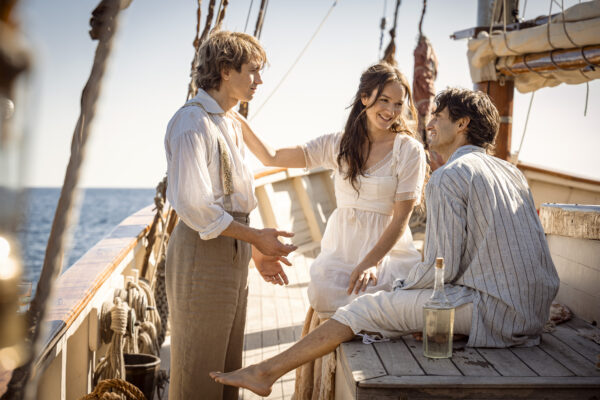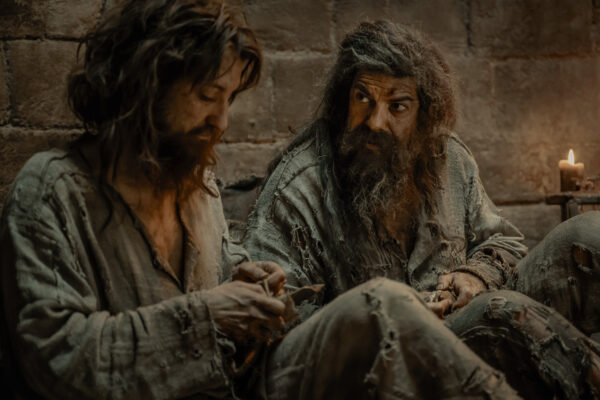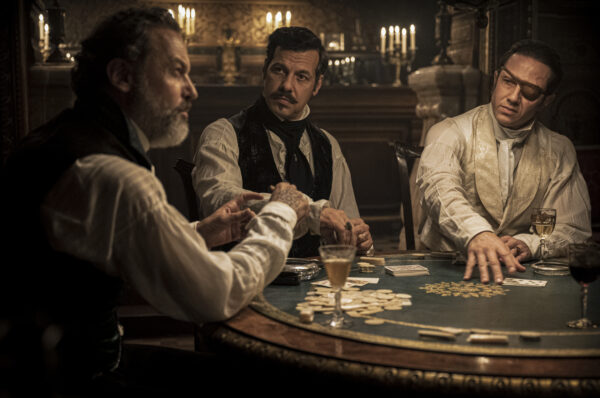
Bastien Bouillon, Anaïs Demoustier and Pierre Niney. Photo courtesy of Samuel Goldwyn Films
The Count of Monte Cristo, a new edition of this oft-told story, adapted and directed by the team of Matthieu Delaporte and Alexandre de la Patellèreof, is a stunningly romantic adventure full of love, hate, greed, betrayal, revenge and resurrection. The villains are painted in the blackest of blacks, but what makes it most interesting are the innocent victims who drive much of the plot and the complex and conflicted hero who is both brave and vengeful.
These are the best and worst of times in France. Napoleon is banished to Elba and the kings are back in power. But that term is in jeopardy as there are rumors that Napoleon's legion of supporters are plotting his return. There was an accident at sea and a ship burned, its passengers lost except for a woman struggling in the water. Captain Danglers has ordered his crew to charge ahead and ignore any survivors from the other ship. Sailor Edmund Dantès ignores the order, dives into the water and saves the woman. Angry that his orders were not followed, he locks the woman Angèle in cramped rooms, confiscates her belongings, including a hidden letter, and tells Dantès that his career is over. The letter? A letter signed by Napoleon to his supporters in France. The woman? A spy and anti-royalist. Danglers will find a use for this letter and win big. As far as Dantès is concerned, things don't go as planned. The owner of the fleet is impressed by his bravery and immediately fires Danglers and replaces him with Dantès, making the 22-year-old Dantès one of the youngest captains in France. Danglers is seething, unhinged, but has a plan to balance the books.
Dantès, a man of humble origins, is thrilled that he now has the means to marry the woman of his dreams: Mercédès, the aristocratic daughter of the estate where Dantès' family has served for years. It was Mercédès' relatives who sent Dantès to the Naval Academy and will be delighted with his promotion. They were perhaps less enthusiastic about their daughter's engagement to a servant's son. But love should conquer all and even Mercédès' cousin Fernand de Morcef seems to support him while secretly seething with jealousy.
The trio of anti-Dantès schemers is rounded off by Gerard de Villefort, the king's prosecutor. Angèle, who was saved from drowning by Dantès, is Villefort's sister and a supporter of Napoleon, which will derail his promising career with the royalists. When Danglers appears with her letter, Villefort falls into a trap in which Danglers offers him a convenient way out that will benefit both of them. Villefort has to make sure that no one finds out who was carrying the letter, and when Danglers offers the prospect of pinning the letter on Edmund Dantès, he pounces.
The king's guards are sent to the church where Dantès and Mercédès are about to exchange their wedding vows and take him to the prosecutor's office. Fernand protests that he is convinced of his innocence and rides to his aid. Instead, Villefort convinces Fernand that a trial against Dantès would tarnish the name of Morcef. Morcef immediately changes sides and swears in a letter that he knows that Dantès is a supporter of Napoleon and a traitor to France. Instead of putting him before a jury, Villefort has Dantès kidnapped to the Chateau d'If, an impregnable prison fortress on an island off the coast of Marseille that everyone assumes he will never see again.

Pierre Niney and Pierfrancesco Davino. Photo courtesy of Samuel Goldwyn Films
Dantès has already been in prison for four years, ragged, starving and hopeless and contemplating suicide when he hears noises behind one of his walls. A prisoner in the adjacent, seemingly impregnable cell has broken through, mistakenly believing that he was about to reach the outer wall facing the sea. He is the Abbé Faria, who was imprisoned when, as the last guardian of the fortune accumulated by the Templar Order, he refused to reveal his whereabouts. He had been digging for years to get to Dantès' cell, and with Dantès's help and if they were lucky, it might only take another ten years for him to reach the outer wall and freedom. Realizing that Dantès is poorly trained, he offers to teach him while he works. It will be a university where he will learn modern and ancient languages, philosophy, history, mathematics and science. And if they reach their destination, Faria has promised to share the hidden loot with him, making him rich beyond measure.
But that's less than an hour into the film, because it's not about his escape, but about what he does afterward. Edmund Dantès understood one thing perfectly. Revenge is a dish best served cold. As the mysterious Count of Monte Cristo who returns to Paris, where all of his targets now live, he is sought after by everyone. Rich, educated, cultured, aristocratic – what he has in store for his enemies will surprise even them. Dantès's cunning and long-term planning raise the question: How much is enough retribution or can it ever be enough?
Written by Alexandre Dumas, a prolific writer of adventure novels reviled by academics and adored by readers of all ages, it was almost as interesting as the characters he wrote. His father, Thomas-Alexandre, was the illegitimate product of a slave and a nobleman, the Marquis de La Pailleterie. The Marquis brought Thomas back to Paris to educate him, but as a farewell for his concubine and her daughters, he sold her to someone else. Thomas, ineligible to inherit the Marquis' estate, was given his freedom and sent to a military school. He began his career in the army as a private soldier and rose to the rank of general under Napoleon at the age of 31. After his early death in 1806, four-year-old Alexandre and his sisters suffered greatly until he began his writing career, first as a journalist and then as a playwright. His plays and minor works, works he wrote with collaborators, brought him wealth, but nothing compared to the recognition and wealth he received for his most important novels, The Corsican Brothers, The Three Musketeers and The Count from Monte Cristo”. ” With the money he earned from the latter two, he built a country house outside Paris and called it Château de Monte-Cristo.
Dumas wrote in an almost cinematic style. His books were page-turners with visual, exciting and haunting scenes that easily translated to the big screen. And that has been the case again and again since 1905. De La Patellière and Delaporte have taken small liberties with some characters, but these changes are almost seamless in terms of the original story.
Nobody does historical drama better than the French. The British come close and the Americans get it right in most cases, mostly using locations in Czechoslovakia and Hungary that are twice as high for 18th and 19th century Western Europe; but nothing like the French who have retained more of their landscape and architecture. This “Count of Monte Cristo” is a feast for the eyes and utilizes existing castles and surrounding properties to give it an authenticity that is hard to duplicate. The hair and make-up department uses wigs and masks to create characters and storylines with great sensitivity. The costumes are contemporary and match the wealth of the main characters and the rags of the wretched, especially those of Edmund, who suffers in the prison fortress. Nicolas Bolduc's cinematography is unparalleled, capturing the lushness of the landscape and the austerity of the unlit prison.

Laurent Lafitte, Patrick Mille and Bastien Bouillon. Photo courtesy of Samuel Goldwyn Films
But this is nothing without the great actors, many of whom are stars of the Comédie Française, who testify to their theatrical experience and the subtlety they bring to their roles. Of particular note are the villains. Bastien Bouillon brings an ambivalence to the evil narcissism of Fernand de Morcef, whose betrayal of Dantès is perhaps the greatest. As Danglers, Patrick Mille has the self-satisfied charisma of a man who cheats, schemes and makes no apologies for his lack of moral compass. It is Laurent Lafitte as Villefort who gives a special meaning to the prosecutor who distrusts everyone and, having the most to lose, is more careful with the others and always sets up a scapegoat whenever possible. But there is no Count of Monte Cristo without the breathtaking performance of Pierre Niney, who gives credibility to his Edmund Dantès, who uses all the colors of an emotional palette and his expressive eyes to tell a story even when there is no dialogue. He is a true marvel of depth, character and believability.
If you like a good story, there is no better than this must-see film.
In French with English subtitles.
Now playing at Laemmle Royal.
